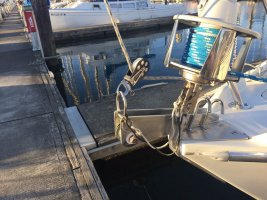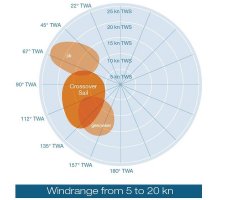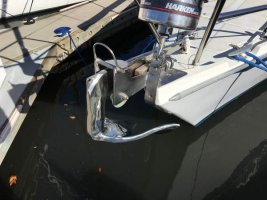G'day to all and especially E38-200 owners,
I would like to ask information about the following 2 questions:
1. how many here are using bails for setting and flying Spinnakers, ASM types or otherwise, where I can get a suitable "bail" to fit my anchor roller?
The SS frames making up the anchor bow roller are outside dimension is 110mm, 4 inches, the ss plates either side of the roller are 6mm, 1/4" thickness.
Inside dimension width being 88mm or 3 1/2".
The dimensions and sizes that I have seen on the WM and Defender sites do not show a bail of this size to suit that I can see.
see the following link for the anchor roller bail I am after, but am not sure where I can purchase one from.
http://kingstonanchors.com/accessories/bails-2/
I am in Bermuda and would order online from USA to ship to me, any suggestions where to purchase from, or happy buy from anyone here that has one to spare that would suit my anchor roller specs above.
2. with regard to my second question, I would like to ask if any one here has comments, experiences, good bad or otherwise recommendations, for or against the use of the ATN Tacker.
All comments from any size vessel owners using the ATN Tacker welcomed.
Hammy in sunny Bermuda.
I would like to ask information about the following 2 questions:
1. how many here are using bails for setting and flying Spinnakers, ASM types or otherwise, where I can get a suitable "bail" to fit my anchor roller?
The SS frames making up the anchor bow roller are outside dimension is 110mm, 4 inches, the ss plates either side of the roller are 6mm, 1/4" thickness.
Inside dimension width being 88mm or 3 1/2".
The dimensions and sizes that I have seen on the WM and Defender sites do not show a bail of this size to suit that I can see.
see the following link for the anchor roller bail I am after, but am not sure where I can purchase one from.
http://kingstonanchors.com/accessories/bails-2/
I am in Bermuda and would order online from USA to ship to me, any suggestions where to purchase from, or happy buy from anyone here that has one to spare that would suit my anchor roller specs above.
2. with regard to my second question, I would like to ask if any one here has comments, experiences, good bad or otherwise recommendations, for or against the use of the ATN Tacker.
All comments from any size vessel owners using the ATN Tacker welcomed.
Hammy in sunny Bermuda.



